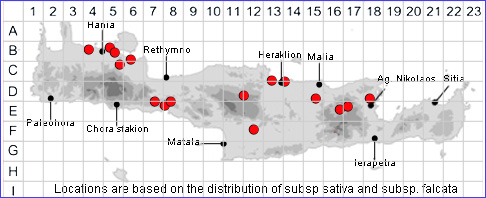SPECIES DESCRIPTION
MEDICAGO VARIA
Family and Genus:- See-- LEGUMINOSAE/Subgen. MEDICAGO
Common Names:- Alfalfa, Lucerne.
Homotypic Synonyms:- None
Meaning:- Medicago (Gr) Median-grass, A name used by the Greek physician
and botanist Dioscorides, from a Persian name for lucerne, or medick.
Varia (L) Differing, changing, diverse, varying.
General description:- Very variable, usually hairy perennial.
Stem:-
1) 20-70 cm. Either erect or procumbent.
Leaves:-
1) Leaflets, obovate to almost linear, long-cuneate, dentate at the apex.
2) Stipules, lanceolate to subulate, entire or dentate at the base.
Flowers:-
1) Peduncles, longer than the subtending leaf.
2) Inflorescence, a dense, 8-25 flowered raceme.
3) Corolla, firstly yellow turning tawny greenish, multicoloured or almost black.
Fruit:-
1) Legume, open spirals with few windings.
Key features:-
1) Corolla, firstly yellow turning tawny greenish, multicoloured or almost black.
2) Legume, open spirals with few windings.
Very variable, particularly in S. and S.E. Europe, where a number of distinct
species have been recognized. In view of the overall variation and the known
frequency of hybridization between M. sativa and M. falcata, two of the most
distinct taxa, it seems best to treat them all as subspecies. Hybrids between
subspecies with bluish and yellow corollas often have green or almost black
corollas. The best-known of these is subsp. falcata x subsp. sativa & M. x varia 1)
1) "Atlas of the Aegean Flora" Book1, Arne Strid 2016.
Habitat:- Cultivated and widely naturalised in field margins, orchards, along brooks,
etc. 0-1100 m.
Distribution:- A widespread and variable Euro-Siberian species. Limited distribution
and rare on Crete. But may well be under recorded.
Flowering time:- May-July.
Photos by:- Steve Lenton

